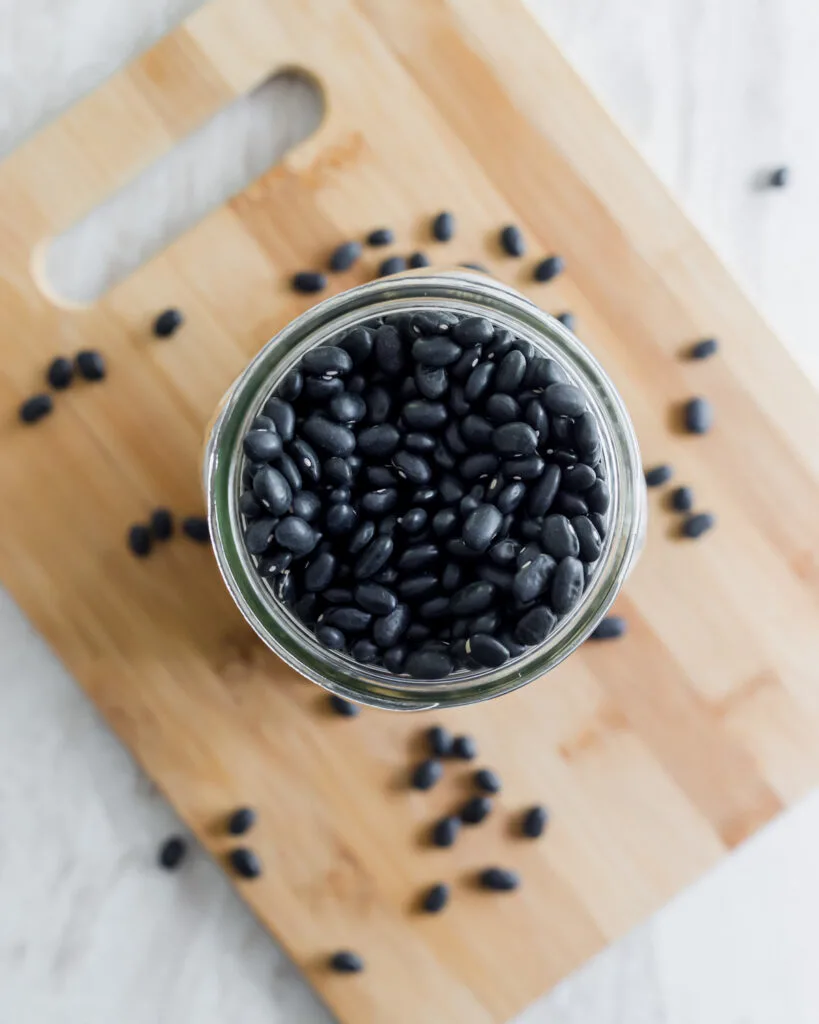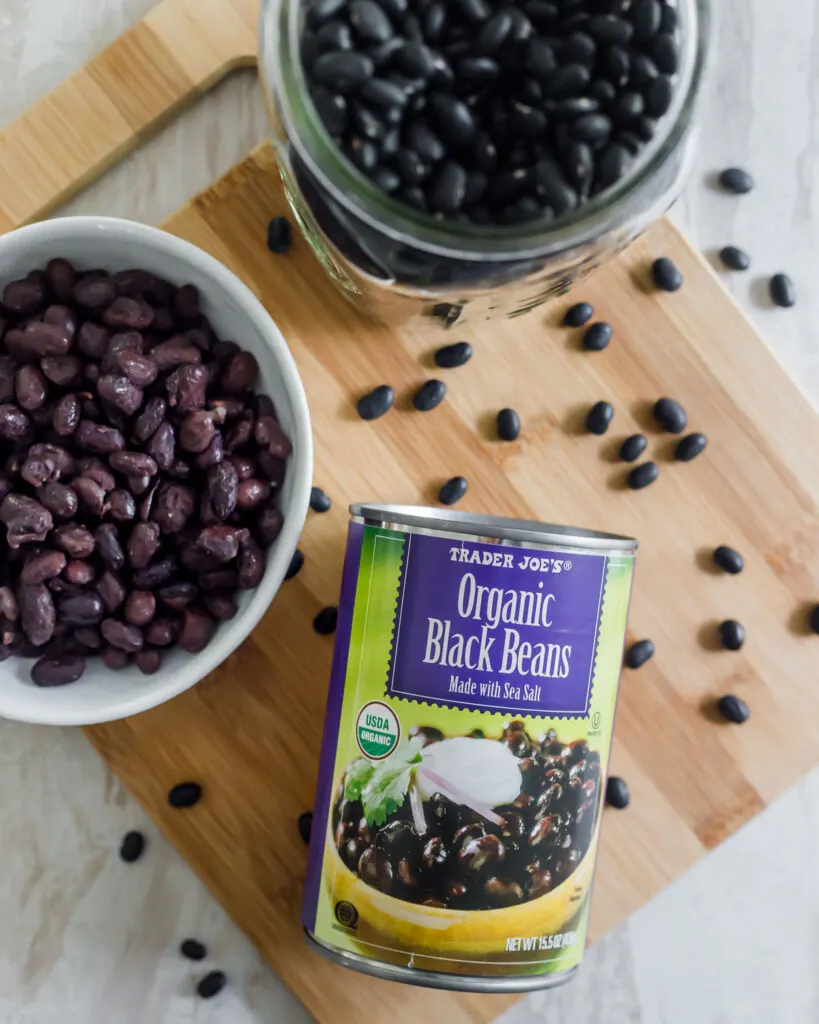Is it safe and healthy to feed dogs black beans? Can dogs eat canned black beans and pressure cooked black beans? Beans are packed with fiber and touted as a health food for humans but are they ok to give to your dog? Read on!

This post may contain affiliate link(s). As an Amazon Associate, I earn from qualifying purchases.
Yes, dogs can eat black beans.
And not just black beans, but many variety of beans can be a healthful addition to your dog’s diet.
As a legume, black beans are rich in both fiber and protein. They’re an excellent plant-based food that can be used to supplement your dog’s food or given as a treat.
No more than 10% of your dog’s diet should consist of black beans.

ARE BLACK BEANS GOOD FOR DOGS?
Black beans are rich in vitamins A, K and C, filled with potassium and high in both iron and magnesium. They’re also a great source of fiber.
Black beans also function as an antioxidant and blood sugar regulator which can help prevent diabetes in dogs.
All these vitamins and nutrients can be beneficial to dogs but it’s important to make sure to not use beans as a meat substitute in your dog’s diet or try to make your dog plant-based using black beans as their protein source.
Dog’s need high quality complete proteins from animal sources to thrive. While omnivores, meat is a crucial component of a dog’s diet.
Overfeeding black beans to a dog can also lead to some undesired side effects such as excessive gas, loose stool and/or abdominal pain. You know the jingle… beans, beans they’re good for your heart… Humans aren’t the only ones it applies to!
CAN DOGS EAT CANNED BLACK BEANS?
Black beans can either be purchased as the dry bean and then cooked or already cooked in cans.
Do not feed your dog dry black beans, or any dry bean! Like humans, dogs cannot digest dry beans.
While canned black beans can be ok to feed to your dog, the caveat is that they’re likely cooked with additional ingredients that may not be safe for dog’s to consume.
If you plan to purchase canned black beans to feed your dog, read the label carefully to make sure there are no added ingredients or spices. The same applies to all canned goods, even sardines which are a great healthy addition to your dog’s diet.
The other thing to lookout for is added sodium.
Even low sodium canned beans still have somewhere around 130mg of sodium per serving. This is completely unnecessary for your dog.
However, if you rinse canned black beans with added sodium you can reduce the sodium content pretty aggressively at which point a small serving can be safe for your dog.
It’s really much better and safer, however, to cook black beans from the dry bean yourself if you plan to use them in your dog’s diet.

HOW TO COOK BLACK BEANS FOR DOGS
When making black beans for your dog, purchase the beans in dry form. You can easily find them in the bulk bins of grocery stores or bagged in the bean aisle.
Either a stovetop method or a pressure cooker like the Instant Pot can be used to cook the beans.
Our preferred method is the Instant Pot as it makes quick work of what can normally be a long process and requires no lengthy soaking.
In just over an hour, you’ll have six cups of cooked black beans ready to be eaten.
Save most for you and some for the dog!
Once cooked, black beans can be added to your dog’s existing food or used in a homemade dog food that includes meat, rice and a vegetable like cauliflower.
The humans might enjoy some black bean meatballs instead.
CAN DOGS EAT BLACK BEANS AND RICE?
Some people ask if dogs can eat rice and black beans and while that’s perfectly fine for the dog to eat, moderation should again be exercised.
Black beans and rice is not a complete and balanced meal for a dog.

Easy Instant Pot Black Beans for Dogs
Learn how to make black beans in the Instant Pot in a breeze that are safe for your dog to eat.
Ingredients
- 1 cup dry black beans, rinsed
- 6 cups water (or combination of water and broth of choice - *see note)
- small pinch Kosher salt
Instructions
- Place all the ingredients in the Instant Pot and set for 30 minutes on manual making sure the valve is set to the "sealing" position.
- Let Instant Pot come to pressure then cook for 30 minutes.
- When the timer goes off, let the pressure release manually for 20 minutes.
- After 20 minutes, turn the valve to "venting" and release the remaining pressure.
- Drain any excess water from the beans and let cool before serving.
Notes
*If using broth to make the beans, take care to choose a broth without ingredients such as onions and garlic that are dangerous to dogs. Homemade is best in this case.
**Note the yield is 12 half cup servings. Your dog will
Nutrition Information:
Yield: 6 Serving Size: 1Amount Per Serving: Calories: 110Total Fat: 0gSaturated Fat: 0gTrans Fat: 0gUnsaturated Fat: 0gCholesterol: 0mgSodium: 24mgCarbohydrates: 20gFiber: 5gSugar: 1gProtein: 7g
This website provides approximate nutrition information for convenience and as a courtesy only. Nutrition information can vary for a variety of reasons. For the most precise nutritional data use your preferred nutrition calculator based on the actual ingredients you used in the recipe.

CAN DOGS EAT REFRIED BEANS?
Refried beans are often made with either pinto beans or black beans.
While both are safe for consumption by dogs, refried beans often use onions, garlic, peppers and vegetable oils in addition to the beans as well as other preservatives that should be avoided in your dog’s diet.
In general, the less processed the better when it comes to any bean and your dog.
It’s best to stick with beans you’ve cooked yourself. This way you know exactly what other ingredients (basically none!) have been used in the cooking process.
